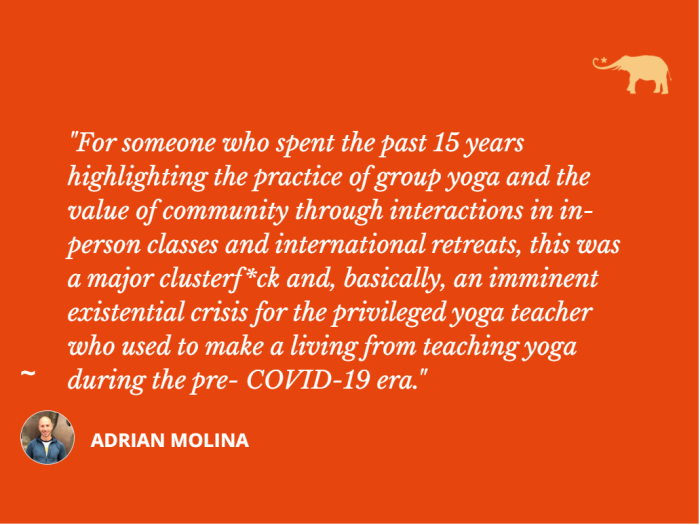View this post on Instagram
When the pandemic first landed and the world went nuts about toilet paper, hand sanitizer, and wiping down fruits and veggies, I didn’t have any other option.
I had to take care of my students during the most acute phase of withdrawing from cozy yoga in studios.
I jumped in the “let’s move online” wagon like the rest of the yoga world, and I tried to make a living teaching yoga through the phone. Call it a Darwinian yogic instinct.
International retreats were out of the picture, and probably even punished with jail time and long community hours if you could get anyone to sign up or get on a plane.
Home had become the new, revamped Costa Rica resort. There were no longer shared bathrooms with strangers, electricity, access to 24/7 Wi-Fi, three meals and snacks, all inclusive, or oversized killer mosquitos.
For someone who spent the past 15 years highlighting the practice of group yoga and the value of community through interactions in in-person classes and international retreats, this was a major clusterf*ck and, basically, an imminent existential crisis for the privileged yoga teacher who used to make a living from teaching yoga during the pre-COVID-19 era.
But like in every story, there was a silver lining:
1. I no longer had to report to the yoga studio manager who wants to make the world a better place while counting how many heads are in my class to define if I am allowed in heaven or will be sent to hell.
2. I no longer had to deal with a corporate chain that wanted me to be more sexy and enthusiastic about my teaching style in order to fit into their global marketing campaign.
3. I no longer had to drive my ass incessantly around South Florida to teach an hour class while spending up to three hours in traffic, and basically losing money.
4. I got to do my own schedule and teach whenever I wanted and what I actually wanted.
5. I got to focus on teaching something that I love and that makes the world a better place without worrying about logistics, front row drama, Karen’s, Ken’s, AC’s, and so on.
Because when life shakes the floor underneath you, you get to reevaluate who you are and what makes you feel alive, so I got to reorient my teaching to help those in the front lines, such as doctors, nurses, and folks struggling with homelessness and mental health challenges.
And I know what you are thinking: doesn’t he misses the in-person classes in yoga studios and the so many loving people who come to those spaces?
Doesn’t he misses the unison sound of the breath while everyone orchestrates their movements together and the transcendental experience of chanting together?
No. Nada. Zero.
In the early stages of the Covid “reopening,” my sorry ass went back to teaching yoga in a studio while wearing a mask. It looked like it was a good choice until it knocked me down for 10 days, and for a year afterward and counting, I felt like someone had stolen my brain and never gave it back.
I am still dealing with long covid symptoms and I haven’t stepped into a yoga studio since then. I have a recurrent heart condition due to that, so I had to redefine what I do for a living to make sure that it doesn’t kill me.
And yet, as I explore this unknown cyber territory, I never felt more connected to the practice like I do now.
I never felt more connected to my students like I do now.
I never experienced so much love for the practice and from my students like I do now. Which makes me wonder…
Was all of that “lifestyle” we created around yoga and the way we used to consume it really necessary?
Was it part of its evolution?
Is where we are now better or worse than where we were before the pandemic in our relationship to yoga?
These are all great questions to think about.
I know that I haven’t made a comeback yet from where I was two years ago. I am still putting the pieces together.
Will yoga make that comeback for us? Only time could tell.
One thing that I am sure of is that the power of this practice of making people feel connected and building loving and nurturing communities is untouched by this pandemic. In fact, it might be more present than ever before—right now, unfolding in front of our screens.











Read 19 comments and reply